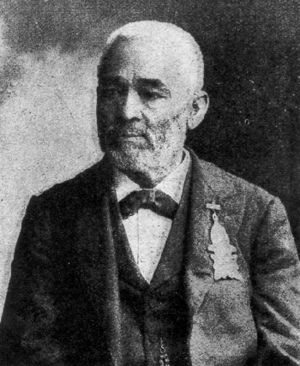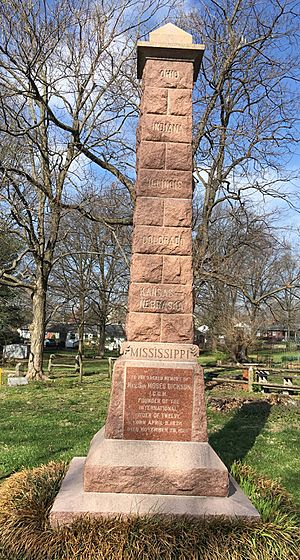Moses Dickson facts for kids
Moses Dickson (1824–1901) was an important leader who fought against slavery in the United States. He was a soldier and a minister. He also started a secret group called the Knights of Liberty. This group planned a large uprising to free enslaved people.
Moses Dickson also helped many enslaved people escape to freedom using the Underground Railroad. Later, he founded a self-help group for African Americans called The International Order of Twelve Knights and Daughters of Tabor. He also helped start Lincoln University in Missouri.
Contents
Moses Dickson's Early Life
Moses Dickson was born free in Cincinnati, Ohio, on April 5, 1824. His father died when he was eight, and his mother died when he was fourteen. He had five sisters and three brothers.
As a young man, he learned to be a barber. At age sixteen, he traveled through the Southern states for three years. He worked as a barber on steamships. What he saw during his travels made him want to end slavery.
The Knights of Liberty and Their Plan
On August 12, 1846, Moses Dickson and eleven other young men met in St. Louis, Missouri. They wanted to create a plan to end slavery in the United States. They formed a secret group called the Knights of Liberty.
Their plan was to organize enslaved people across the South. They would train them and then, in ten years, fight for freedom. Dickson said they took a secret oath: "I can die, but I cannot reveal the name of any member until the slaves are free."
After ten years, this group had grown very large. Dickson said they had 42,000 members in every Southern state except Texas and Mississippi. These armed men met secretly at night and practiced for the uprising.
Dickson said they expected to have almost 200,000 men ready to fight. Their orders were to "spare women and children" and treat prisoners well. They were told to "March, fight and conquer, or leave their bodies on the battlefield."
However, the leaders decided to postpone the uprising. They saw that the relationship between the North and South was getting worse. The Civil War was about to begin. Dickson told the Knights of Liberty to "wait, have patience, hold together."
Dickson later spoke to the famous abolitionist John Brown in Davenport, Iowa. This was just before Brown's raid on Harpers Ferry in 1859. Dickson tried to tell Brown it was too early for an uprising, but Brown went ahead anyway.
Helping People Through the Underground Railroad
Starting in 1850, the network of the Knights of Liberty was also used to help enslaved people escape. This was part of the Underground Railroad. A smaller secret group, the Order of Twelve, was created in Galena, Illinois. It used St. Louis as its main base and helped hundreds of enslaved people reach freedom.
Dickson raised money for the Underground Railroad. He also directly planned individual escapes. He even said that some slave owners helped them. These owners did not agree with slavery and had nothing to fear from the Railroad.
One helper was General Cassius Clay of Kentucky. He gave Dickson $1,000 for the Railroad. People in England also sent money and even weapons to help.
Dickson told a story about seeing a mother and daughter sold in New Orleans. He arranged for them to be "stolen" and dressed as boys. They then got jobs on a steamboat and eventually reached freedom in Canada.
Another man was helped to escape by being put in a wooden box. He was shipped out of Charleston, South Carolina. After reaching the North, this man called himself Henry "Box" Brown. He later wrote a book about his life.
After the Civil War: Education and Community
During the Civil War, the Knights of Liberty group stopped meeting. Many members, including Dickson, joined the Union Army. After the war, Dickson focused on education and helping newly freed people.
He joined the African Methodist Episcopalian Church in 1866. He became a minister the next year. In 1869, Dickson became a Grand Master of the Prince Hall Masons in Missouri.
He started schools for Black children. He also worked to make sure Black teachers were hired for these schools. With other Black Union soldiers, he helped start the "Lincoln Institute." This school later became Lincoln University in Jefferson City, Missouri. He also helped create the Missouri Equal Rights League.
In 1879-1880, Reverend Dickson led the Refugee Relief Board. This group helped about 16,000 African Americans from the South. These people were moving to Kansas and other states as part of the Exoduster movement.
In 1872, Dickson and his wife, Mary Elizabeth, created a new group. It was called the International Order of Twelve Knights and Daughters of Tabor. This organization helped African Americans improve their lives. It encouraged good behavior, getting property and wealth, and education.
This group, also known as the Order of Twelve, accepted men and women equally. Men and women met together in higher levels of the organization. Like many groups at the time, members received money if they were sick and help with burial costs.
Moses Dickson's Personal Life
Moses Dickson married Mary Elizabeth Butcher Peters on October 5, 1848, in Galena, Illinois. They had one daughter, Mamie Augusta.
Mary Elizabeth also worked with the Underground Railroad. She traveled with her husband on his speaking tours. She helped start The Order of Twelve. She was also a dedicated worker in the AME Church. She was known as Mother Dickson, and her husband was called Father Dickson. Their marriage was seen as an equal partnership. Mary Elizabeth died in 1891. She is remembered as an early Black woman who helped others through giving and service.
Moses Dickson's Death
Reverend Moses Dickson died from typhoid fever on November 28, 1901. Thousands of people from all over the United States attended his funeral. It was held at St. Paul's AME Church in St. Louis. He is buried at the Father Dickson Cemetery in Crestwood, Missouri.



